Abstract
There is growing evidence that the standard Weibull strength distribution is not always accurate for the description of variability in tensile strength and its dependence on the gauge size of brittle fibers. In this work, a modified Weibull model by incorporating the diameter variation of bamboo fiber is proposed to investigate the effect of fiber length and diameter on the tensile strength. Fiber strengths are obtained for lengths ranging from 20 to 60 mm and diameters ranging from 196.6 to 584.3 μm through tensile tests. It is shown that as the within-fiber diameter variation increases, the fracture strength of the bamboo fiber decreases. In addition, the accuracy of using weak-link scaling predictions based on the standard and modified Weibull distribution are assessed, which indicates that the use of the modified distribution provides better correlation with the experimental data than the standard model. The result highlights the accuracy of the modified Weibull model for characterizing the strength and predicting the size dependence of bamboo fiber.
1. Introduction
Most of the thermomechanical properties of fiber-reinforced composites are affected by the strength distribution of the constituent fibers. In the past few decades, these composite materials have commonly utilized traditional reinforcing fibers (such as glass and carbon) as reinforcement, but recently, environmental concerns have generated a resurgence of interest in using natural fibers. In particular, plant fibers, such as coir, flax and sisal, are emerging as potential alternatives for man-made fibers in polymer-based composites. It is now widely accepted that natural fibers and biocomposites made from natural sources integrate sustainable, eco-friendly and relatively low-cost industrial products, which can replace the dominance of petroleum-based products in the future [1].
Presently, bamboo fiber is being considered an important alternative reinforcement to synthetic fibers and has great potential to be used in structural polymer composites [2]. However, one of the main concerns for industrial application is a much higher variability in the mechanical properties of this natural product. Because the bamboo fibers are extracted by retting followed by mechanical processing, the mechanical properties of the obtained fibers are affected by the natural variability in the plant, by the processing stage and by the damage sustained during processing [3]. In comparison with synthetic fibers, bamboo fibers have a significantly higher variation in diameter between fibers and within a fiber [4,5]. As a consequence, natural fibers exhibit considerable strength variation, which is found to be correlated to fiber diameter and length. In other words, this means that there is no specific value to represent their strength. This leads to the necessity of employing an efficient method for the evaluation of the fiber strength and the prediction of its size dependence.
Knowledge of the mechanical behavior of an advanced fibrous composite requires a comprehensive evaluation of the strength of the fibers. Many attempts have been made for strength prediction in the fibers. The distribution of the failure stress of brittle fibers, such as carbon [6], ceramic [7] and jute fibers [8], is most often characterized using the Weibull statistics. This model is based on the failure of a chain in which the weakest link controls rupture and seems to be well adapted to describe a set of tensile test results carried out at one gauge length [9]. Existing analytical models for the tensile failure of fibers can be divided into two groups according to the Weibull rule. Models in the first group are based on the two- or three-parameter model, which is called the standard Weibull model or linear-law model. However, there is a growing amount of experimental data suggesting that the standard Weibull distribution shows the inadequacies for describing the experimentally observed fiber strength scatter and the strength dependence on the size [10]. Models of the second group are based on the power-law model [8,11], which is a modified form of the standard Weibull model. Such an analysis introduces a parameter that represents the fiber diameter variations and succeeds in reconciling the mismatch of the fiber strength scatter at a fixed gauge length. However, most attempts have paid attention to studying the within-fiber diameter variation. Very few of the models try to investigate the effect of between-fiber diameter variation on the tensile strength.
Contrary to the previous studies, of primary interest in the present study is implementing the modeling of the statistical distribution of facture strength. Tensile experiments are conducted to estimate the statistical strength properties for the bamboo fibers over a variation of lengths ranging from 20 to 60 mm and diameters ranging from 196.6 to 584.3 μm. The standard Weibull model is modified by incorporating the diameter variation to investigate the effect of fiber length and diameter on the tensile strength. In addition, weak link scaling analysis is conducted to check the validity of the proposed mode for predicting the fracture strength and its size dependence.
2. Experimental Procedure
The bamboo fibers (density of 1.035 g/cm3) used in this work were delivered from Ban, Ltd., Tokushima, Japan. They were selected from one of the most common bamboo species, known as Moso bamboo. All samples were extracted from the bamboo culms of at least three years of age. The tensile tests were conducted using a WDW3050 computer-controlled universal testing machine (Kexin Testing Instrument Co., Ltd., Changchun, China) that registered the displacement of the clamps and the force applied to the fiber. Each fiber specimen was mounted on a stiff paper frame. The fiber length outside the frame determined the gauge length. To fix the fibers as straightly as possible between the clamps, fiber ends were glued with a double-sided adhesive onto the paper frame in accordance with the preparation procedure described in ASTM (American Society for Testing and Materials) D3379-89 [12]. Upon clamping of the ends of the frame by the jaws of the testing machine, frame sides were carefully cut in the middle, as shown in Figure 1.
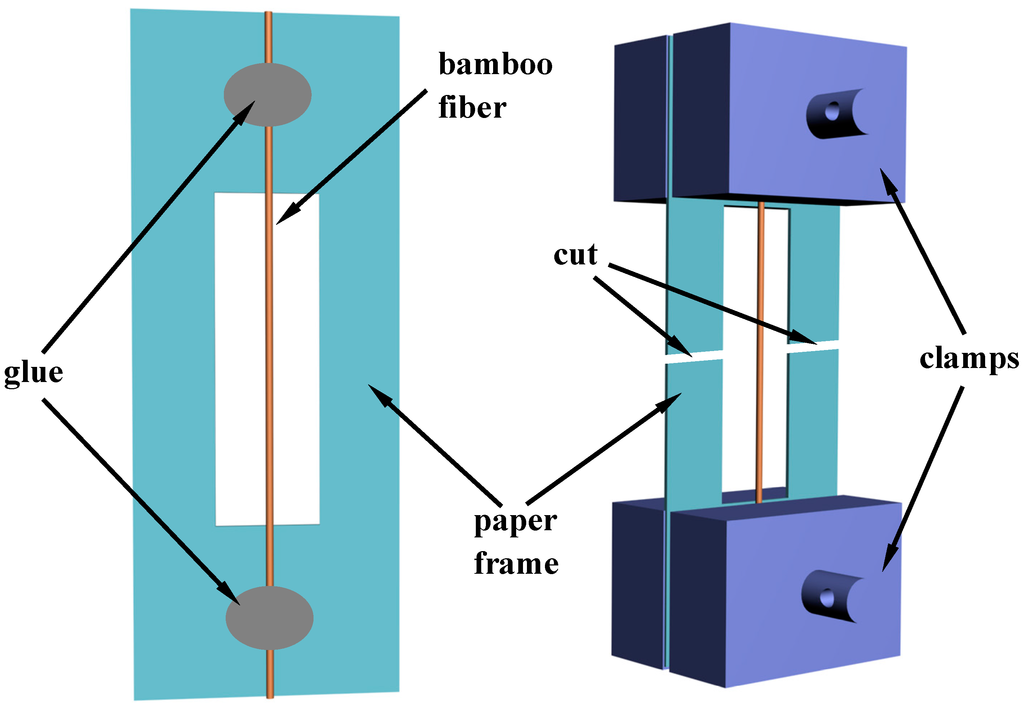
Figure 1.
Schematic of the fixture set-up for the fiber tensile test.
In order to investigate the influence of a variety of fiber dimensions on the fracture properties, bamboo fibers were used to produce sets of samples at five different gauge lengths with 20, 30, 40, 50 and 60 mm and at five different test diameters with 196.6, 317.3, 398.4, 508.8 and 584.3 μm at a 20-mm gauge length. Indeed, in this batch of samples, fibers were found to normally range from 150 to 600 μm in diameter. Therefore, they were divided into five typical groups that were capable of representing a significant variation in average diameter between fibers. Meanwhile, these grouping diameters were selected based on the consideration that the average diameter at each of the five groups was constant within an accuracy of ±15 μm. At least 20 individual samples were mounted for testing at each of these fiber sizes, because samples broken close to the end had not been considered in the analysis. Consequently, a total of 238 fiber tests were carried out for obtaining 20 qualified specimens per test size. It should be noted that special care was taken during handling in order to avoid the creation of additional defects and changes to flaw distributions.
All static tests were displacement controlled with a cross head speed of 0.5 mm/min, which were performed at ambient conditions. A load cell of 200 N was applied for all fiber specimens. The load-displacement curve was recorded during the test. The cross-sectional area was evaluated from the diameter measured using an optical microscope at five different locations along each sample length. Although the bamboo fiber cross-section has a polygonal shape and fiber thickness varies somewhat along the fiber [3], the average cross-sectional area, needed to convert the applied loads to stresses, is calculated by assuming that each individual fiber has a constant cross-section and is perfectly circular in shape [13]. Through image analysis of the fracture profile in Figure 2, bamboo fiber seems to have a brittle fracture behavior, shaped by a filoselle.
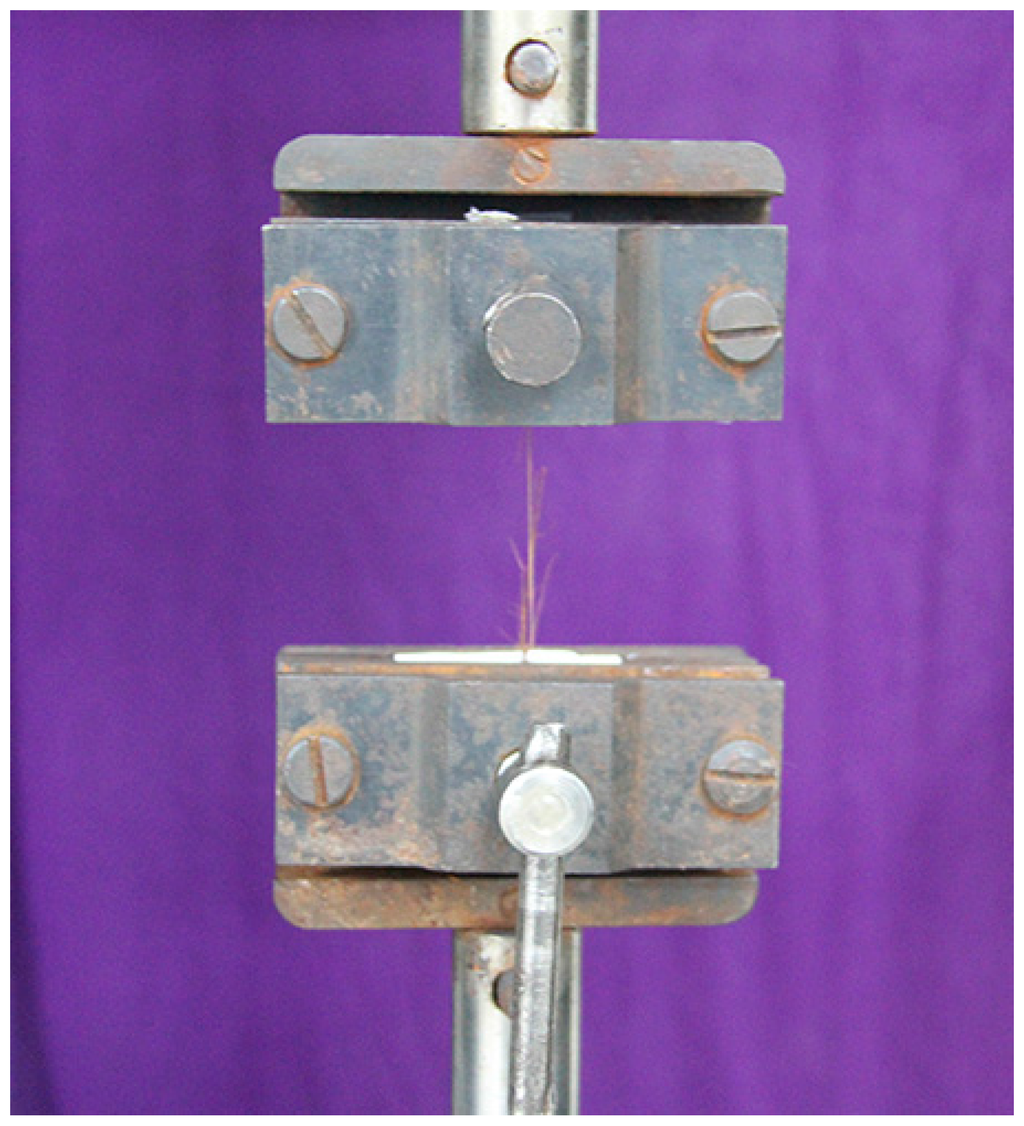
Figure 2.
Fracture profile of a bamboo fiber.
3. Statistical Modeling
Weibull analysis is a widely-used statistical tool for describing the strength behavior of brittle materials, which is based on the assumption that failure at the most critical flaw leads to total failure of the specimen [14,15]. Owing to the varying severity of flaws along the volume of the fibers, the strength of fibers is found to be statistically distributed. Therefore, the distribution of fiber strength, σf, under tension is generally described by means of the standard Weibull model [16]:
where P is the failure probability of the fiber. κ is the Weibull modulus, which defines the variability of the distribution. A lower κ corresponds to a broad distribution of fracture strength and a higher κ to a narrow distribution. σ0 is the characteristic Weibull strength corresponding to a reference gauge volume V0. V is the fiber volume.
By rearranging and taking the natural logarithm of both sides of Equation (1), the following expression is obtained:
For a constant tested volume, Equation (2) is reduced to:
Hence, a plot of X = ln σf vs. should give a straight line if the material strength variability is described by the Weibull distribution. The shape parameter κ and the scale parameter σ0 can be determined by plotting X against Y.
The cumulative probability of failure P of the fiber can be estimated as median ranks assigned to the measured strength values, σfi, at each gauge length and diameter, using the following approximation:
where n is the number of data points (i.e., the number of strength measurements performed at the given gauge size). i is the rank of the i-th number in the ascending ordered strength data point (i = 1 corresponds to the smallest and i = n corresponds to the largest).
According to the nature of the mathematical function, the average value of can be calculated with Equation (1):
where Γ is the gamma function.
Equation (1) assumes that the defect density is homogeneously distributed over the volume of the material. In other words, the defect distribution is regarded as a function of the length and diameter of the fiber. If a bamboo fiber has a circular cross-section, the volume of the fiber is V = (1/4) × πD2L. D is the fiber diameter, and L is the gauge length. Consequently, Equation (1) can be expanded to:
Thus, for the constant fiber diameter, the resulting Weibull distribution is identical to Equation (1), except that volumes are substituted by lengths (L):
where L0 is the reference length and L is the fiber length.
To consider the effect of fiber diameter, for the constant gauge length L, Equation (6) can be written as:
where D0 is the reference diameter and D is the fiber diameter.
Therefore, the average strength based on Equations (7) and (8) is given by, respectively:
However, bamboo fibers are quite different from man-made fibers, especially in their variable geometrical structure, such as between-fiber and within-fiber diameter variation. For example, variations in cross-sectional area along the length of a fiber induce variations in stress that may lead to a different overall fiber strength compared to a constant fiber cross-section with the same average area [5]. There is some experimental evidence suggesting that the above conventional Weibull model does not always adequately describe the fiber strength and its dependence on the fiber volume for many natural fibers [8]. As a consequence, a modified form of Equation (1) was suggested by Watson and Smith [17]:
where γ is the exponential parameter that is a measure of the sensitivity of the strength to the test volume V. The lower γ, the lower the decrease of strength for increasing volume V. It is an empirical parameter that is introduced to improve the predictive level of the Weibull model with respect to experimental data. The modified (power-law) model has been justified to have a wider applicability than the standard (linear-law) model [8]. The reason is that under the framework of the modified model, the equation has taken into account the effect of not only the diameter variation between the fibers, but also the within-fiber diameter variation, especially for natural fibers. The parameters involved in the distribution of Equation (11) can be calculated by the maximum likelihood estimation (MLE) from the strength data.
Therefore, Equations (9) and (10) can be changed as follows:
where the reference length L0 and reference diameter D0 are chosen to be 1 mm and 1 μm for mathematical convenience, respectively.
4. Results and Discussion
4.1. Statistical Distribution for Tensile Strength
Strength variability is caused by the inherent flaw distribution along a fiber and by the fiber-to-fiber strength variability within a batch of fibers, due to variations in processing and damage introduced by the handling of the fibers [5]. In order to analyze the statistical distribution of fiber strength, a plot for the tensile strength for the four different test lengths of 20, 30, 40 and 50 mm in Weibull coordinates is shown in Figure 3.
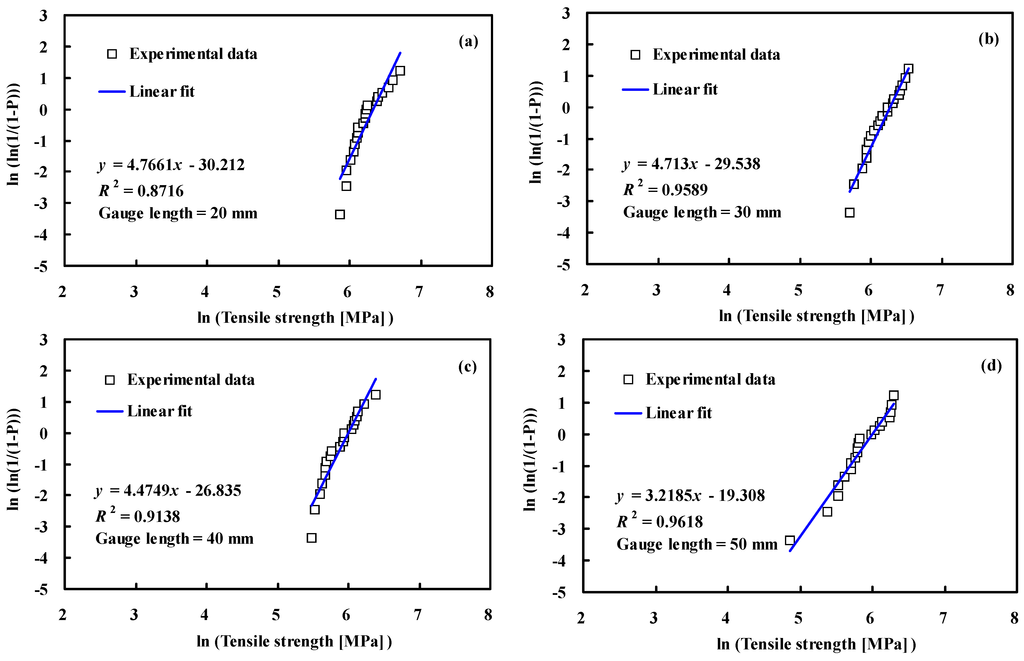
Figure 3.
Weibull plots for different gauge lengths of bamboo fiber: (a) 20-mm length; (b) 30-mm length; (c) 40-mm length; and (d) 50-mm length.
In addition, Figure 4 presents Weibull plots for the four different test diameters of 317.3, 398.4, 508.8 and 584.3 μm. Although some deviation from the best-fit line occurred at the high and low strength extremes, reasonably conformity is demonstrated between the best straight line fit and the experimental data points for most gauge dimensions with a relatively high coefficient (R2). Some differences may be the result of uncertainties from experiments. Therefore, the tensile strength of bamboo fiber exhibits a statistical variation, which can be quantified by a unimodal Weibull model (Equation (3)).
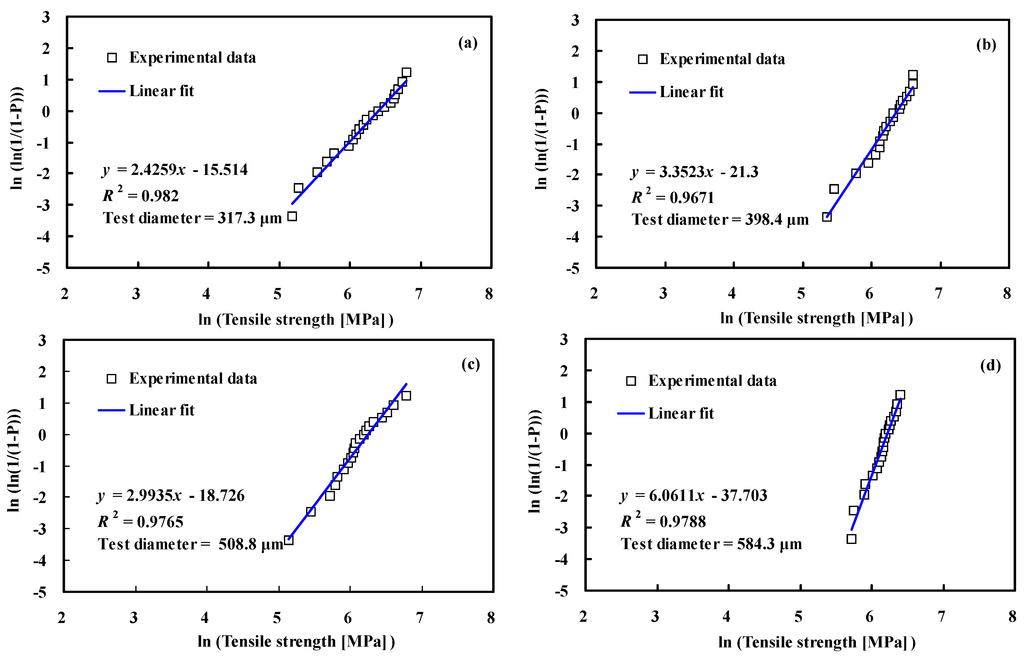
Figure 4.
Weibull plots for different test diameters of bamboo fiber: (a) 317.3-μm diameter; (b) 398.4-μm diameter; (c) 508.8-μm diameter; and (d) 584.3-μm diameter.
The Weibull modulus and characteristic strength at each gauge length and diameter tested are fitted using the least squares method, which are summarized in Table 1 and Table 2, respectively. For most natural fibers, the common values for κ range between one and six, and synthetic fibers usually have shape factors between 2 and 20; however, the Weibull modulus is found to be between two and six for all tested bamboo fibers, which is in the same range in comparison with other natural fibers. Our results demonstrate that the bamboo fibers obtained by the extraction process have a large scatter in their strength distribution, which is expected due to the statistical nature of the fracture. Moreover, as a result of the increased likelihood of a flaw in a larger size, the characteristic strength of bamboo fibers decreases as the gauge size increases.

Table 1.
Weibull parameters for the tensile strength of bamboo fibers at different test lengths. CVFD, coefficient of variations of fiber diameter.
| Gauge length, L (mm) | Number of Specimens, N | Shape parameter, κ | Scale parameter, σ0 (MPa) | Linear coefficient, R2 | CVFD |
|---|---|---|---|---|---|
| 20 | 20 | 4.77 | 566 | 0.87 | 0.055 |
| 30 | 20 | 4.71 | 527 | 0.96 | 0.058 |
| 40 | 20 | 4.47 | 402 | 0.91 | 0.063 |
| 50 | 20 | 3.22 | 403 | 0.96 | 0.065 |

Table 2.
Weibull parameters for the tensile strength of bamboo fiber at different test diameters.
| Test diameter, D (μm) | Number of Specimens, N | Shape parameter, κ | Scale parameter, σ0 (MPa) | Linear coefficient, R2 |
|---|---|---|---|---|
| 317.3 ± 15 | 20 | 2.43 | 599 | 0.98 |
| 398.4 ± 15 | 20 | 3.35 | 575 | 0.97 |
| 508.8 ± 15 | 20 | 2.99 | 521 | 0.98 |
| 584.3 ± 15 | 20 | 6.06 | 503 | 0.98 |
4.2. Size Dependence of Fiber Strength
The average tensile strength of four plots of bamboo fibers from measurements is presented as a function of gauge lengths in Figure 5. Twenty samples were measured for each data point. These data indicate that the fiber strength is sensitive to gauge length, which means a decrease in fracture strength with increasing gauge length. This can be attributed to the fact that the fibers with a longer gauge length have a greater amount of lower strength in the same quantity, which is expected to, on average, have a lower average strength compared with smaller fibers. This trend has been seen elsewhere with brittle fibers [3,18] and provides support for the fact that with larger test lengths, there are more flaws in the fibers, which make the probability of failure higher [19].
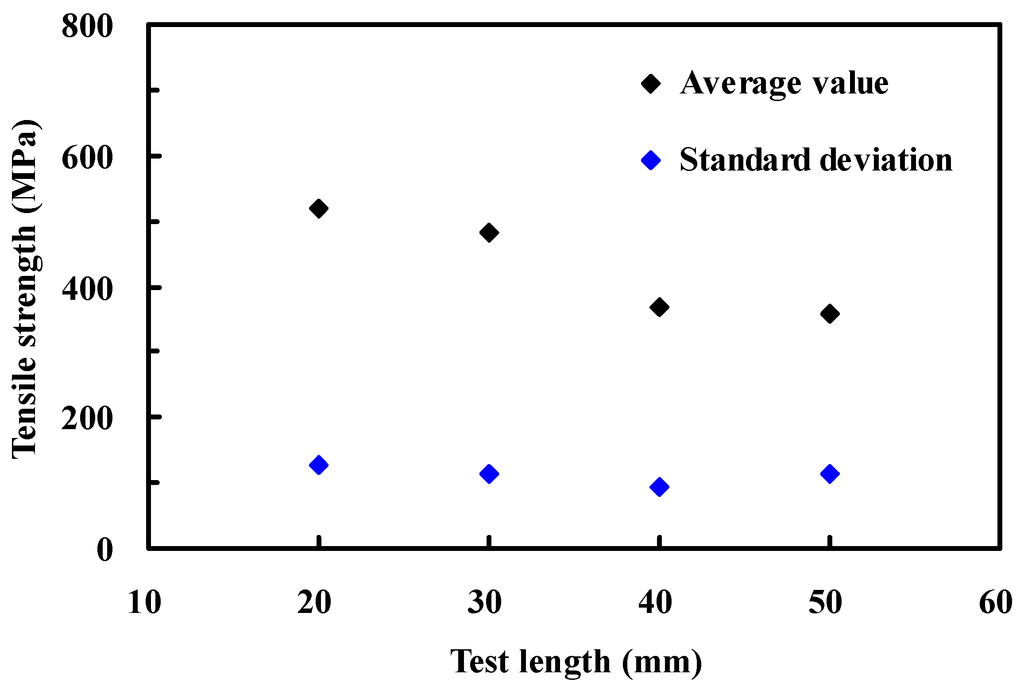
Figure 5.
Dependence of the tensile strength of bamboo fiber on the test length.
In order to investigate the effect of the within-fiber diameter variation on the strength, the coefficient of variations of fiber diameter (CVFD) is taken as an indicator of the variation in the fiber diameter. It should be mentioned that CVFD is the average value of diameter variation coefficients of 20 fibers at each gauge length in this study. The relationship between the CVFD and the testing gauge length is provided in Figure 6, which indicates that the CVFD value of bamboo fibers increases with increasing gauge length. In addition, Table 1 reveals an effect of the CVFD on the fracture strength. As expected and as a result of the increased likelihood of flaws in a fiber with greater diameter variability, the strength of the bamboo fiber decreases [8].
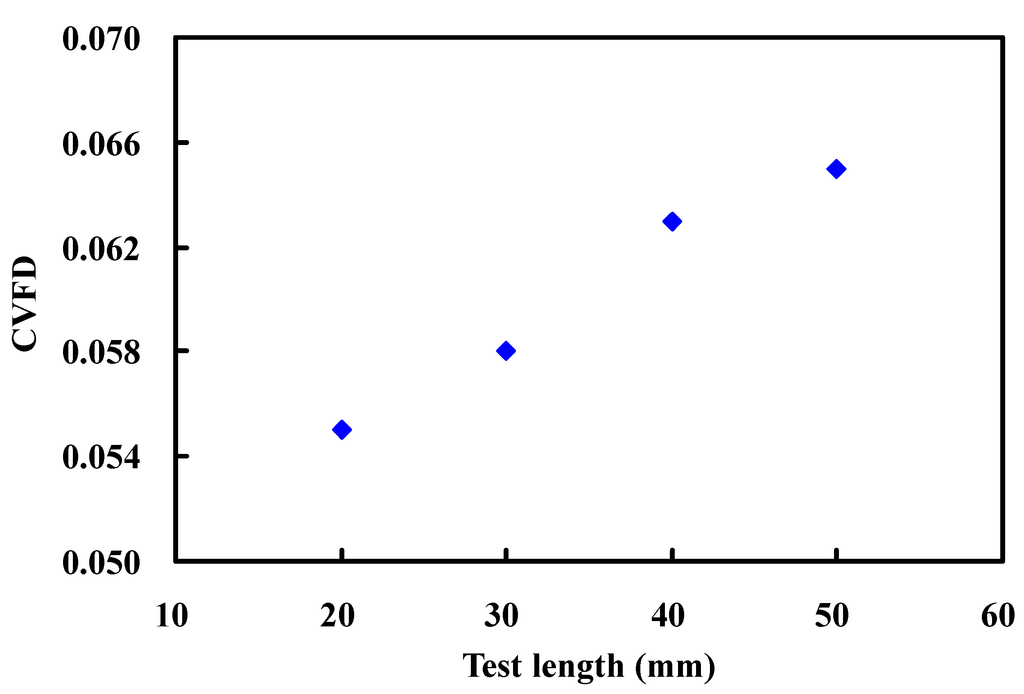
Figure 6.
Coefficient of variations of fiber diameter as a function of test length.
To study if the defect density distribution is, besides a function of fiber length, also, a function of fiber surface area, the effect of the diameter of bamboo fiber on its tensile strength is taken into consideration. Figure 7 shows the dependency of the fracture strength on the fiber diameter for bamboo fibers tested at a fixed gauge length of 20 mm. From this comparison, it is clear that there is an obvious dependence of the measured strength on the test diameter, which indicates that the between-fiber diameter variation has a negative effect on the fracture strength. In other words, the fiber strength decreases with increasing fiber diameter. There is a need to state that when grouping together fibers with varying diameters, the average diameter for each test group is assumed to be constant within 15 μm, which suggests that the diameter along a fiber length shows a low variance. Therefore, the effect of the CVFD on the tensile strength is not considered whilst studying between-fiber diameter variation in this study.
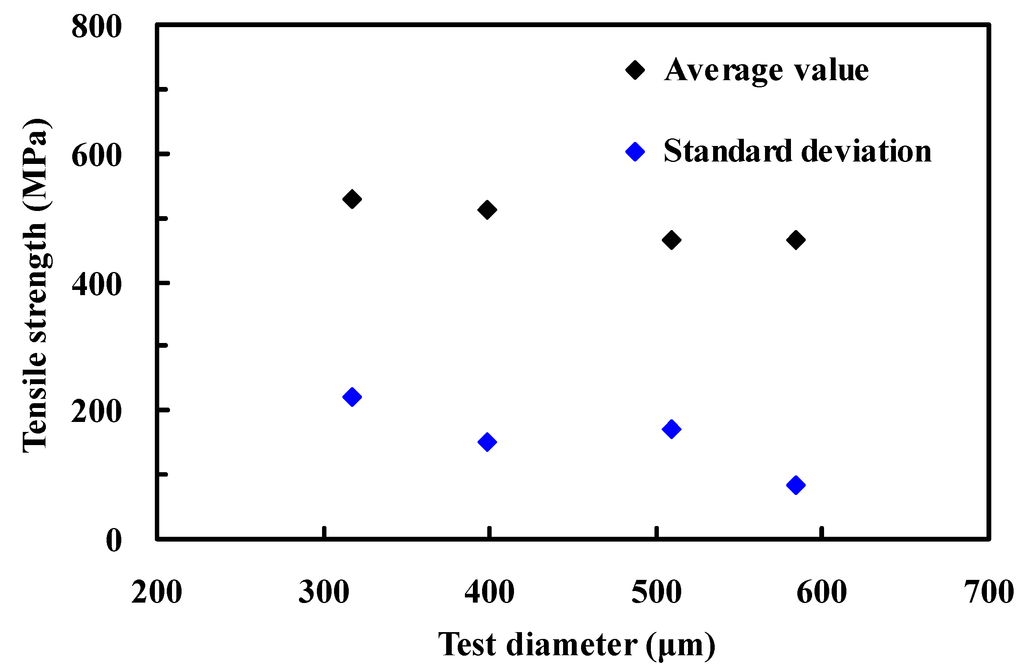
Figure 7.
Tensile strength of bamboo fiber as a function of test diameter.
In these above two graphs, it is interesting to note that the size effect of the strength is observed not only in the axial direction, but also in the radial direction of the fiber. Differences in fracture strength and the size effect cannot only be caused by the accumulation of defects along the fiber, but also by between-fiber and within-fiber diameter variations.
4.3. Weak-Link Scaling
Although weak-link scaling predictions assume that the strength can be scaled for any fiber length from a single weak link point estimate at a chosen fiber gauge length, some evidence has justified that method based on the standard Weibull form is unable to accurately predict the fiber strengths across the range of data [20]. In addition, Virk et al. [21] conducted a comprehensive investigation of the weak-link scaling analysis for fiber strength predictions, which stressed that the use of multiple dataset (MDS) weak-link scaling predictions can provide better correlation with the experimental data than the standard single dataset (SDS) weak link scaling method (a point estimate).
In order to assess the accuracy of weak-link scaling predictions for MDS estimates, the standard and modified Weibull distribution are used to predict the strength of bamboo fibers for different gauge lengths simultaneously. Optimized Weibull parameter estimates for strength are computed from the strength data for 20- and 50-mm gauge lengths, which can bound the entire range of test lengths [21]. Table 3 gives the specific values determined by the MLE method. The comparison of the average strength values at 20-, 30-, 40-, 50- and 60-mm gauge lengths predicted by using the standard and modified Weibull distribution analysis with the experimentally obtained average values is shown in Table 4. As would be expected, the scaling model based on the modified distribution can give a closer fit to the experimental data than the standard model.

Table 3.
Weak-link Weibull estimates for tensile strength in the fiber length direction.
| Term | Scale parameter, σ0 (MPa) | Shape parameter, κ | Exponential parameter, γ |
|---|---|---|---|
| Standard model | 1200 | 3.7 | - |
| Modified model | 1658 | 3.9 | 1.4 |

Table 4.
Comparison of the measured and predicted tensile strength at different test lengths.
| Gauge length used for strength prediction (mm) | Predicted strength (MPa) | Measured strength a (MPa) | |
|---|---|---|---|
| Standard model | Modified model | ||
| 20 | 482 (−7.0) b | 509 (−1.7) | 518 |
| 30 | 432 (−10.6) | 440 (−8.9) | 483 |
| 40 | 400 (8.9) | 396 (8.0) | 367 |
| 50 | 376 (4.5) | 366 (1.6) | 360 |
| 60 | 358 (1.7) | 348 (−1.1) | 352 |
a Average value of 20 results; b Values in parenthesis denote difference error (%).
To study the scale effect on the fiber strength in the radial direction, both the standard model and the modified one are used to perform strength scaling on the fiber diameter. The computed parameters κ and σ0 are estimated by the MLE method that stems from the two datasets, including D = 317.3 and 584.3 μm, given in Table 5. The dependence of the tensile strength on the test diameter is shown in Table 6. It can be visually observed that there is a significant discrepancy between experimental and standard Weibull predicted strength values, which shows that extrapolation using the standard model is not really sufficient for predictive modeling of fiber strength with different between-fiber diameters. However, the fracture strength predicted by the modified Weibull distribution is more approximate to the experimental data than that of the standard Weibull model. This can explain that the standard model cannot comprehensively describe fiber strength with diameter increasing, but the modified model takes into consideration the volume change of each fiber, such as the external or internal structure change and diameter variation of the fiber [22].

Table 5.
Weak-link Weibull estimates for tensile strength in the fiber radial direction.
| Term | Scale parameter, σ0 (MPa) | Shape parameter, κ | Exponential parameter, γ |
|---|---|---|---|
| Standard model | 1200 | 10.4 | - |
| Modified model | 6909 | 3.8 | 0.8 |

Table 6.
Comparison of measured and predicted tensile strength at different test diameters.
| Test diameter used for strength prediction (μm) | Predicted strength (MPa) | Measured strength a (MPa) | |
|---|---|---|---|
| Standard model | Modified model | ||
| 196.6 | 414 (−27.6) b | 623 (8.9) | 572 |
| 317.3 | 378 (−28.5) | 566 (7.2) | 528 |
| 398.4 | 362 (−29.7) | 515 (0.1) | 514 |
| 508.8 | 345 (−25.8) | 462 (−0.6) | 465 |
| 584.3 | 336 (−27.8) | 439 (−5.6) | 465 |
a Average value of 20 results; b Values in parenthesis denotes difference error (%).
5. Conclusions
In this work, the strength of bamboo fibers was quantified in order to have a better understanding of the behavior of the final composite materials. To obtain a realistic estimate of the fiber properties, a large population of bamboo fibers was individually tested in tension using various gauge dimensions. The fracture strength distribution of bamboo fibers is statistically analyzed using a modified Weibull model to evaluate the effect of different size variables: fiber length and diameter. The obtained results reveal a size effect of fiber strength in both axial and radial directions, in good agreement with experimental observation. The reduction in mechanical properties in bamboo fibers with increasing fiber specimen size is not only caused by the accumulation of defects over the volume of a material, but also by between-fiber and within-fiber diameter variations.
Furthermore, the predicted scaling of fiber strength with both length and diameter has been verified. It is shown that the modified Weibull distribution is much more appropriate than the standard Weibull distribution for the description of the strength distribution of the bamboo fibers at different gauge dimensions, which is attributable to the fact that the modified Weibull distribution can take into account the effect of variations in diameter between fibers and within a fiber.
Acknowledgments
The authors gratefully acknowledge the financial support of the National Science Foundation of China under Grant Number 11102169 and the Fundamental Research Funds for the Central Universities under Grant Numbers XDJK2013B019, XDJK2013D011. The authors would also like to express their gratitude to the National Center for Nanoscience and Technology for the equipment support and Ban Ltd., Tokushima, Japan, for the free supply of bamboo fibers.
Author Contributions
Fang Wang is responsible for planning and analyzing the experimental details and has contributed to the writing of the manuscript. Jiaxing Shao is working on experimental measurement.
Conflicts of Interest
The authors declare no conflict of interest.
References
- Abdul Khalil, H.P.S.; Bhat, I.U.H.; Jawaid, M.; Zaidon, A.; Hermawan, D.; Hadi, Y.S. Bamboo fibre reinforced biocomposites: A review. Mater. Des. 2012, 42, 353–368. [Google Scholar] [CrossRef]
- Huang, X.S.; Netravali, A. Biodegradable green composites made using bamboo micro/nano-fibrils and chemically modified soy protein resin. Compos. Sci. Technol. 2009, 69, 1009–1015. [Google Scholar] [CrossRef]
- Andersons, J.; Spārniņš, E.; Joffe, R.; Wallström, L. Strength distribution of elementary flax fibres. Compos. Sci. Technol. 2005, 65, 693–702. [Google Scholar] [CrossRef]
- Peponi, L.; Biagiotti, J.; Torre, L.; Kenny, J.M.; Mondragon, I. Statistical analysis of the mechanical properties of natural fibers and their composite materials. I. Natural fibers. Polym. Compos. 2008, 29, 313–320. [Google Scholar]
- Trujillo, E.; Moesen, M.; Osorio, L.; van Vuure, A.W.; Ivens, J.; Verpoest, I. Bamboo fibres for reinforcement in composite materials: Strength Weibull analysis. Compos A 2014, 61, 115–125. [Google Scholar] [CrossRef]
- Pickering, K.L.; Murray, T.L. Weak link scaling analysis of high-strength carbon fibre. Compos. A 1999, 30, 1017–1021. [Google Scholar] [CrossRef]
- Wilson, D.M. Statistical tensile strength of Nextel™ 610 and Nextel™ 720 fibres. J. Mater. Sci. 1997, 32, 2535–2542. [Google Scholar] [CrossRef]
- Xia, Z.P.; Yu, J.Y.; Cheng, L.D.; Liu, L.F.; Wang, W.M. Study on the breaking strength of jute fibres using modified Weibull distribution. Compos. A 2009, 40, 54–59. [Google Scholar] [CrossRef]
- Berger, M.H.; Jeulin, D. Statistical analysis of the failure stresses of ceramic fibres: Dependence of the Weibull parameters on the gauge length, diameter variation and fluctuation of defect density. J. Mater. Sci. 2003, 38, 2913–2923. [Google Scholar] [CrossRef]
- Paramonov, Y.; Andersons, J. A family of weakest link models for fiber strength distribution. Compos. A 2007, 38, 1227–1233. [Google Scholar] [CrossRef]
- Zhang, Y.P.; Wang, X.G.; Pan, N.; Postle, R. Weibull analysis of the tensile behavior of fibers with geometrical irregularities. J. Mater. Sci. 2002, 37, 1401–1406. [Google Scholar] [CrossRef] [Green Version]
- Standard Test Method for Tensile Strength and Young’s Modulus for High Modulus Single-Filament Materials (Withdrawn 1998); ASTM D3379-75; ASTM International: West Conshohocken, PA, USA, 1975.
- Rao, K.M.M.; Rao, K.M. Extraction and tensile properties of natural fibers: Vakka, date and bamboo. Compos. Struct. 2007, 77, 288–295. [Google Scholar] [CrossRef]
- Amornsakchai, T.; Cansfield, D.L.M.; Jawad, S.A.; Pollard, G.; Ward, I.M. The relation between filament diameter and fracture strength for ultra-high-modulus polyethylene fibres. J. Mater. Sci. 1993, 28, 1689–1698. [Google Scholar] [CrossRef]
- Thomason, J.L. On the application of Weibull analysis to experimentally determined single fibre strength distributions. Compos. Sci. Technol. 2013, 77, 74–80. [Google Scholar] [CrossRef]
- Weibull, W.A. Statistical distribution function of wide applicability. J. Appl. Mech. 1951, 3, 293–297. [Google Scholar]
- Watson, A.S.; Smith, R.L. An examination of statistical theories for fibrous materials in the light of experimental data. J. Mater. Sci. 1985, 20, 3260–3270. [Google Scholar] [CrossRef]
- Defoirdt, N.; Biswas, S.; de Vriese, L.; Tran, L.Q.N.; van Acker, J.; Ahsan, Q.; Gorbatikh, L.; van Vuure, A.; Verpoest, I. Assessment of the tensile properties of coir, bamboo and jute fibre. Compos. A 2010, 41, 588–595. [Google Scholar] [CrossRef]
- Sutherland, L.S.; Shenoi, R.A.; Lewis, S.M. Size and scale effects in composites: I. Literature review. Compos. Sci. Technol. 1999, 59, 209–220. [Google Scholar] [CrossRef]
- Wang, F.; Shao, J.X.; Li, X. Statistics on the fracture strength of bamboo fibers. Polym. Compos. 2015. [Google Scholar] [CrossRef]
- Virk, A.S.; Hall, W.; Summerscales, J. Multiple Data Set (MDS) weak-link scaling analysis of jute fibres. Compos. A 2009, 40, 1764–1771. [Google Scholar] [CrossRef]
- Amada, S.; Ichikawa, Y.; Munekata, T.; Nagase, Y.; Shimizu, H. Fiber texture and mechanical graded structure of bamboo. Compos. B 1997, 28, 13–20. [Google Scholar] [CrossRef]
© 2014 by the authors; licensee MDPI, Basel, Switzerland. This article is an open access article distributed under the terms and conditions of the Creative Commons Attribution license (http://creativecommons.org/licenses/by/4.0/).